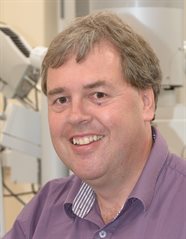Invited speaker: Paul A. Gunning

Paul worked from 1984-2004 at the BBSRC Institute of Food Research (IFR, Norwich, UK) in colloid science and microscopy, investigating emulsion stabilization and protein/surfactant systems at air/water and oil/water interfaces, obtaining an MSc by research (Salford/NEWI).
Paul joined Smith & Nephew in 2004 and is currently ‘Science Manager, Surface Analysis’ at Smith & Nephew’s New R&D facilities Hull, UK. Paul leads a cross-disciplinary team using SEM/ED-X, µ-XRF, LM, Raman and IR microscopy, µ-XCT, contact angle and (occasionally) AFM. His team provide global support of R&D, Patents/IP and Manufacturing (pseudo-forensic troubleshooting, QA and Regulatory/Safety) and also provide scientific support for Marketing departments across the company. Paul and his team are involved in two EU funded Joint Research Programs (EMPIR 15HLT01 MetVBadBugs and EURAMET 14IND12 INNANOPART programs) and he currently serves on the Engineering and Physical Sciences Section Committee of the Royal Microscopical Society.
email: paul.gunning@smith-nephew.com
Use of µ-XCT in the medical device industry
Globally, healthcare systems are facing increased demand from ageing populations due to increasing societal pressure to maintain active lifestyles and fitness for work past the age of 60 years. The Medical Device industry has a critical role to play in addressing these issues by innovating to find ever more cost-effective products. Measurement is critical to demonstrating safety and efficacy of new and existing medical devices and to securing intellectual property within this stringently regulated industry. Image analysis offers powerful methodologies for extracting ‘measurements’ from 2 and 3 dimensional images, but many analyses involve a degree of subjectivity when selecting image features based on a greyscale or colour threshold/segmentation. This presentation will provide examples of measurement challenges with respect to both Wound Care and Orthopaedic medical devices, covering both manufacturing qualification and new product development:
Determination of gas cell size distribution in polyurethane foams was historically achieved using scanning electron microscopy of 2-dimensional surfaces across multiple cross-sections, but the methodology suffered from potential stereographic errors (inferring 3-dimensional data from 2-dimesnional cross-sections). Use of µ-XCT for this analysis provides less potential for stereographic error, whilst also enabling larger statistical datasets to be obtained with minimal physical perturbation to the foams.
Bioresorbable implants offer a bone-conserving surgical method for the deployment of connective tissue repair products such as tendon-repair suture anchor systems. Explanted tissue µ-XCT provides a rapid and relatively non-destructive method to determine the extent of resorption and new bone growth for pre-clinical evaluation of such products and the non-destructive nature of µ-XCT is helpful in pinpointing regions of interest within explants for lengthier classical histology/pathology specimen preparation.